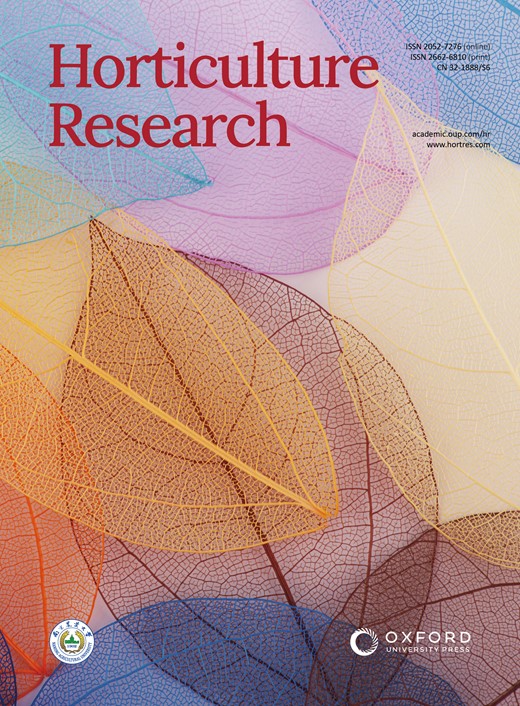染色体水平的整合基因组学和代谢组学揭示了中华藓单萜类生物合成和腺毛形成之间的调控网络
IF 8.5
1区 农林科学
Q1 Agricultural and Biological Sciences
引用次数: 0
摘要
香如属Lamiaceae科一年生草本植物,原产植物为Mosla chinensis (Mc, 2n=18)及其拟栽培品种M. chinensis ' jiangxiangangru ' (McJ, 2n=18),具有健脾功能,被广泛用作药用和食用植物。然而,基因组资源的缺乏阻碍了对湘如的深入研究。本研究对Mc和McJ的形态特征和挥发性有机化合物(VOC)含量进行了分析,结果表明Mc的毛状体密度和单萜类化合物积累量更高,而McJ的生物量更高。我们组装了优质Mc、McJ和掺假M. soochowensis (2n=18)基因组,分别为426.1、408.8和412.8 Mb,重复序列分别为57.17%、56.33%和55.83%。比较基因组学表明Mosla辐射约13.3 Mya,支持McJ最初是自然形成的资源。通过比较转录组鉴定出5个单萜合成酶基因,它们催化多种单萜骨架的生成,其中TPS1介导γ-萜烯的形成,CYP71D179和SDR2介导最终生成香芹酚和百里香酚。我们进一步探讨了单萜类生物合成与毛状体发育的相关性,表明MIXTA和WIN1分别通过直接结合TPS1和CYP71D179启动子共同调节毛状体形成和VOC积累。本研究填补了香薷属基因组的空白,完善了芳香中药挥发性化合物的生物合成和调控机制,也为香薷的优质育种提供了新的靶点。本文章由计算机程序翻译,如有差异,请以英文原文为准。
Integrative chromosome-level genomics and metabolomics uncover regulatory networks linking monoterpenoid biosynthesis and glandular trichome formation in Mosla chinensis
Xiangru, with Mosla chinensis (Mc, 2n=18) and its considered cultivar M. chinensis ‘Jiangxiangru’ (McJ, 2n=18) as original plants, are annual herbs of the Lamiaceae family, and is widely used as medicinal and edible plant due to its spleen strengthening function. However, absence of genomic resource impedes in-depth research towards Xiangru. In this study, the morphological characteristics and volatile organic compounds (VOC) contents of Mc and McJ were analyzed, showing higher trichome density and monoterpenoids accumulation obtained in Mc, whereas McJ possessed higher biomass. We assembled high-quality Mc, McJ and their adulterant M. soochowensis (2n=18) genomes of 426.1, 408.8 and 412.8 Mb, respectively, containing the repeat sequences of 57.17%, 56.33%, and 55.83%. Comparative genomics indicating Mosla radiating ~13.3 Mya, supporting McJ initially as a natural naturally formed resource. Five monoterpene synthase genes were identified through comparative transcriptome, and were responsible for catalyzing production of diversified monoterpene skeleton, in which TPS1 mediate formation of γ-terpinene, accompanied by CYP71D179 and SDR2 leading to the final production of carvacrol and thymol. We further explore correlation between monoterpenoids biosynthesis and trichome development, indicating MIXTA and WIN1 jointly regulate both trichome formation and VOC accumulation by directly binding promotors of TPS1 and CYP71D179, respectively. Our study fills vacancy of genus Mosla genomes, improving the biosynthetic and regulatory mechanism of volatile compounds in aromatic Traditional Chinese Medicine, also offering novel targets for quality-directed breeding in Xiangru.
求助全文
通过发布文献求助,成功后即可免费获取论文全文。
去求助
来源期刊

Horticulture Research
Biochemistry, Genetics and Molecular Biology-Biochemistry
CiteScore
11.20
自引率
6.90%
发文量
367
审稿时长
20 weeks
期刊介绍:
Horticulture Research, an open access journal affiliated with Nanjing Agricultural University, has achieved the prestigious ranking of number one in the Horticulture category of the Journal Citation Reports ™ from Clarivate, 2022. As a leading publication in the field, the journal is dedicated to disseminating original research articles, comprehensive reviews, insightful perspectives, thought-provoking comments, and valuable correspondence articles and letters to the editor. Its scope encompasses all vital aspects of horticultural plants and disciplines, such as biotechnology, breeding, cellular and molecular biology, evolution, genetics, inter-species interactions, physiology, and the origination and domestication of crops.
 求助内容:
求助内容: 应助结果提醒方式:
应助结果提醒方式:


